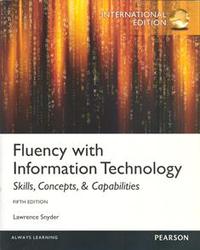Fluency with Information Technology: Skills, Concepts, and Capabilities, 5/e (IE-Paperback)
暫譯: 資訊科技流暢度:技能、概念與能力,第5版 (IE-平裝本)
Lawrence Snyder
- 出版商: Prentice Hall
- 出版日期: 2011-12-31
- 售價: $1,250
- 貴賓價: 9.8 折 $1,225
- 語言: 英文
- ISBN: 0273774387
- ISBN-13: 9780273774389
-
相關分類:
Computer-Science
下單後立即進貨 (約5~7天)
商品描述
<內容簡介>
Fluency with Information Technology: Skills, Concepts, and Capabilities equips readers who are already familiar with computers, the Internet, and the World Wide Web with a deeper understanding of the broad capabilities of technology. Through a project-oriented learning approach that uses examples and realistic problem-solving scenarios, Larry Snyder teaches readers to navigate information technology independently and become effective users of today’s resources, forming a foundation of skills they can adapt to their personal and career goals as future technologies emerge.
Features
Through three different types of content —skills, concepts, and capabilities— Fluency with Information Technology prepares students to adapt to an ever-changing computing environment through lifelong learning:
*Skills consist of competence and proficiency with contemporary computer applications like email, word processing, and Web searching. Skills make the technology immediately useful to students and ground students’ learning of other content in practical experience.
*Concepts are the fundamental principles upon which information technology is based, such as how computers work, digital representation of information, and assessment of information authenticity. Concepts provide the principles on which students will build new understanding as IT evolves.
*Capabilities are the aptitude to apply higher-level thinking in complex situations, such as problem solving, reasoning, complexity management, and troubleshooting. Capabilities embody modes of thinking that are essential to exploiting IT, but they apply in many other situations as well.
In-chapter and end-of-chapter features encourage Fluency with Information Technology (FIT):
*fitTIP: Practical hints and suggestions for everyday computer use.
*fitBYTE: Interesting facts and statistics.
*fitCAUTION: Warnings and explanations of common mistakes.
*Try It: Short, in-chapter exercises with solutions provided.
*Checklists: A useful list of steps for completing a specific task.
*Great fit Moments: A historical look at some of the major milestones in computing.
*Great fit Minds: A closer look at some of the influential pioneers in technology.
New to This Edition
Briefly, the four parts of Fluency have been changed as follows:
*Part I has received a complete makeover. Chapters 1 “Introducing Terms”, 2 “Human-Computer Interface”, and 5 “Web” are new. Chapters 3 “Internet” and 4 “HTML” have been revised. Chapter 6 (formerly Chapter 7) “Debugging” has been updated with a new fully worked example. (The former Chapter 6, “Case Study of Online Research.” was eliminated, and the critical content such as “authoritativeness of sources” moved to Chapter 5.)
*In Part II Chapter 7 “Multimedia” received a complete makeover. Chapter 10, “Algorithms” is new, building on a Chapter 1 introduction to the topic and a key algorithm from Chapter 5. The two other chapters of Part II benefit from several important revisions.
*In Part III, Chapter 11 “Social Implications” is mostly new, and Chapter 12 “Privacy and Security” is completely restructured: The RSA encryption material has moved to Appendix B, and an entirely new encryption treatment replaces it; viruses and worms have moved to this chapter, and other valuable features – developing a personal security plan – have been retained. Chapter 16 “XML Database” received a wholesale revision.
*Finally, in Part IV Chapter 22, “AI” has up-to-date coverage of IBM’s Watson. Only the JavaScript material has remained essentially unchanged.
The number of “Try It” inline exercises in the chapters has tripled. The End of Chapter Exercises have been heavily revised; many new exercises have been added.
<章節目錄>
Part 1 Becoming Skilled at Computing
Chapter 1 Defining Information Technology
Chapter 2 Exploring the Human-Computer Interface
Chapter 3 The Basics of Networking
Chapter 4 A Hypertext Markup Language Primer
Chapter 5 Locating Information on the WWW
Chapter 6 An Introduction to Debugging
Part 2 Algorithms and Digitizing Information
Chapter 7 Representing Information Digitally
Chapter 8 Representing Multimedia Digitally
Chapter 9 Principles of Computer Operations
Chapter 10 Algorithmic Thinking
Part 3 Data and Information
Chapter 11 Social Implications of IT
Chapter 12 Privacy and Digital Security
Chapter 13 The Basics of Spreadsheets
Chapter 14 Advanced Spreadsheets for Planning
Chapter 15 Introduction to Database Concepts
Chapter 16 A Case Study in Database Organization
Part 4 Problem Solving
Chapter 17 Fundamental Concepts Expressed in JavaScript
Chapter 18 A JavaScript Program
Chapter 19 Programming Functions
Chapter 20 Iteration Principles
Chapter 21 A Case Study in Algorithmic Problem Solving
Chapter 22 Limits to Computation
Chapter 23 A Fluency Summary
商品描述(中文翻譯)
內容簡介
《資訊科技流暢性:技能、概念與能力》為已熟悉電腦、網際網路及全球資訊網的讀者提供更深入的技術能力理解。透過以專案為導向的學習方法,使用範例和現實問題解決情境,Larry Snyder教導讀者獨立導航資訊科技,成為當今資源的有效使用者,並為未來技術的出現奠定可調整的技能基礎,以適應個人和職業目標。
特色
- 透過三種不同類型的內容——技能、概念和能力——《資訊科技流暢性》準備學生適應不斷變化的計算環境,並進行終身學習:
*技能(Skills)包括對當代電腦應用(如電子郵件、文字處理和網頁搜尋)的能力和熟練度。技能使技術對學生立即有用,並將學生的其他內容學習根植於實際經驗中。
*概念(Concepts)是資訊科技的基本原則,例如電腦如何運作、資訊的數位表示和資訊真實性的評估。概念提供學生在資訊科技演變過程中建立新理解的原則。
*能力(Capabilities)是指在複雜情境中應用高階思維的能力,例如問題解決、推理、複雜性管理和故障排除。能力體現了利用資訊科技所需的思維模式,但也適用於許多其他情境。
- 章內及章末特色鼓勵《資訊科技流暢性》(FIT):
*fitTIP:日常電腦使用的實用提示和建議。
*fitBYTE:有趣的事實和統計數據。
*fitCAUTION:常見錯誤的警告和解釋。
*Try It:短小的章內練習,並提供解答。
*Checklists:完成特定任務的有用步驟清單。
*Great fit Moments:計算機歷史上一些重大里程碑的回顧。
*Great fit Minds:對一些技術先驅的深入探討。
新版本的變更
- 簡而言之,《資訊科技流暢性》的四個部分已進行如下變更:
*第一部分已完全改版。第1章「術語介紹」、第2章「人機介面」和第5章「網頁」為新章。第3章「網際網路」和第4章「HTML」已修訂。第6章(前身為第7章)「除錯」已更新,並提供全新完整範例。(前第6章「線上研究案例研究」已刪除,關鍵內容如「來源的權威性」已移至第5章。)
*在第二部分,第7章「多媒體」已完全改版。第10章「演算法」為新章,基於第1章對該主題的介紹和第5章中的關鍵演算法。第二部分的其他兩章也經過幾項重要修訂。
*在第三部分,第11章「社會影響」大部分為新內容,第12章「隱私與安全」則完全重組:RSA加密材料已移至附錄B,並由全新的加密處理取代;病毒和蠕蟲已移至此章,並保留其他有價值的特色——制定個人安全計畫。第16章「XML資料庫」經過全面修訂。
*最後,在第四部分,第22章「人工智慧」對IBM的Watson進行了最新的報導。只有JavaScript的內容基本保持不變。
- 章內的「Try It」練習數量已增加三倍。章末練習經過大幅修訂,新增了許多練習。
章節目錄
第一部分 成為計算技能者
第1章 定義資訊科技
第2章 探索人機介面
第3章 網路基礎
第4章 超文本標記語言入門
第5章 在WWW上尋找資訊
第6章 除錯入門
第二部分 演算法與數位化資訊
第7章 數位表示資訊
第8章 數位表示多媒體
第9章 電腦操作原則
第10章 演算法思維
第三部分 數據與資訊
第11章 資訊科技的社會影響
第12章 隱私與數位安全
第13章 試算表基礎
第14章 規劃的進階試算表
第15章 資料庫概念入門
第16章 資料庫組織案例研究
第四部分 問題解決
第17章 用JavaScript表達的基本概念
第18章 一個JavaScript程式
第19章 程式功能
第20章 迭代










